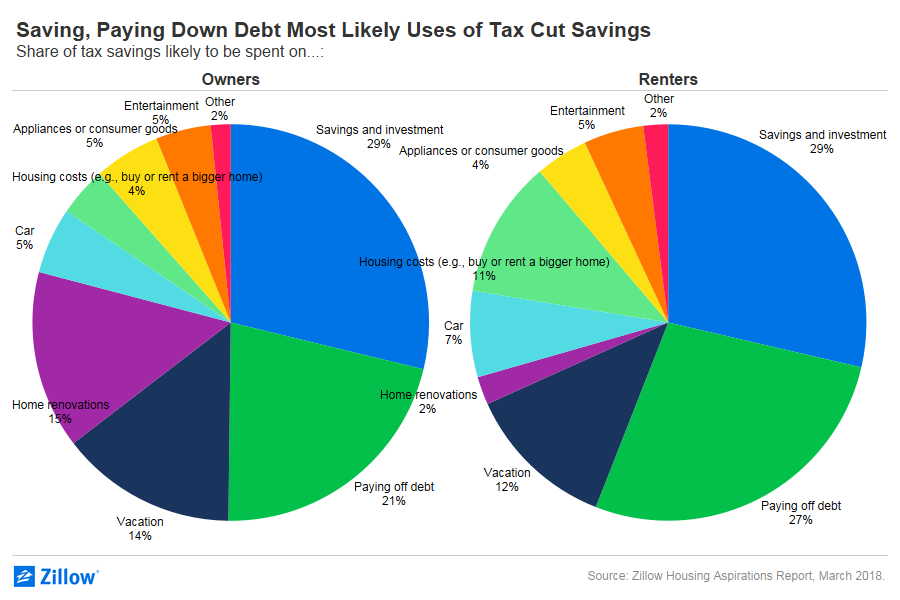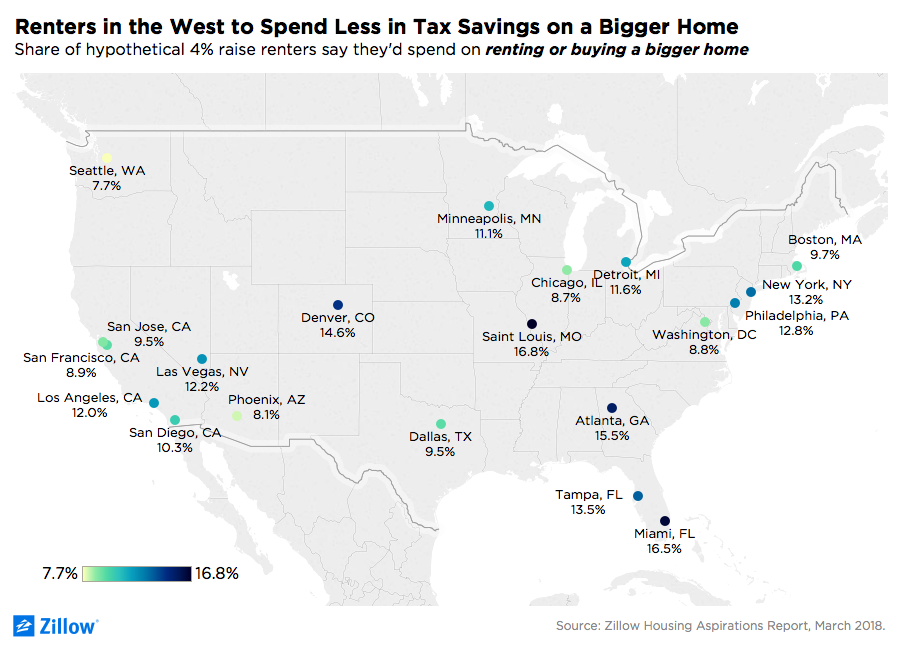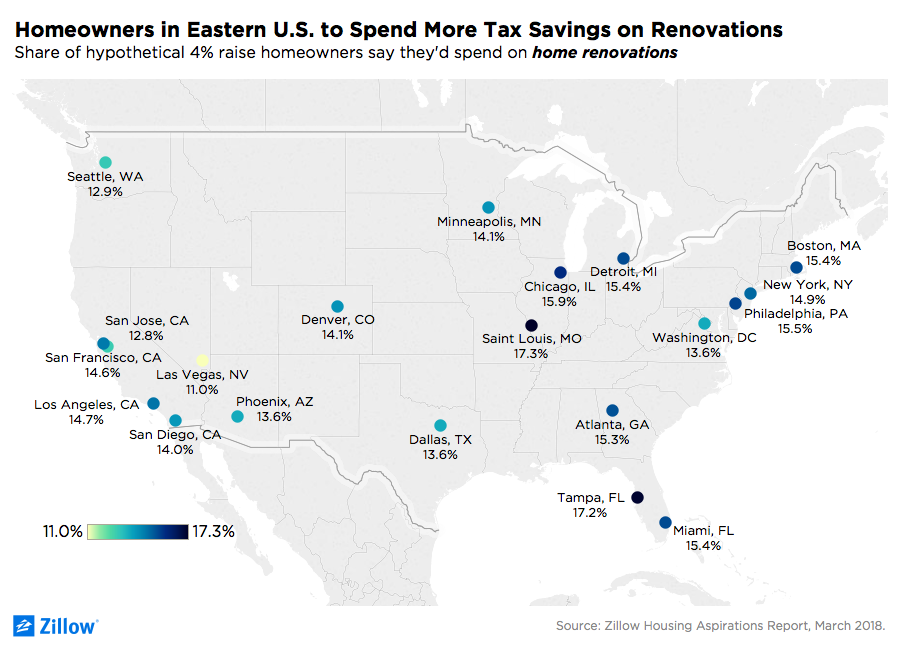- Zillow estimates homeowners and renters could put $13.2 billion in tax savings directly into the American housing market in 2018, using some of their tax cut to rent or buy a bigger home.
- Americans will likely spend almost double that amount – an additional $24.7 billion – on home renovations in 2018.
- Lower-income households are likely to spend a larger portion of their tax cut on housing: 12.2 cents on the dollar for households in the bottom income quintile, compared to 3.6 cents on the dollar for households in the top income quintile.
The Tax Cuts and Jobs Act (TCJA) enacted in December is likely to result in tens of billions of dollars being reinvested into housing in some form or another – despite the fact the legislation expressly limited a number of longstanding tax benefits for homeowners.
Zillow estimates homeowners and renters could put $13.2 billion in tax savings directly into the American housing market in 2018, using some of their tax cut to rent or buy a bigger home.[1] Americans will likely spend almost double that amount – an additional $24.7 billion – on home renovations in 2018, and will add about $62.6 billion to their savings and investments, according to results of the most recent Zillow Housing Aspirations Report (ZHAR).[2]
The net effect of the TCJA was to reduce most Americans’ federal tax liability and increase their after-tax income, in large part by lowering marginal tax rates and increasing the standard deduction. Many are likely to spend at least some of these gains, however small, on housing – despite new limits on tax benefits historically aimed at homeowners, including the mortgage interest deduction and deductions for state and local property taxes.
ZHAR asked more than 10,000 respondents nationwide and in 20 large markets how they would spend a hypothetical “raise” roughly equal to the expected average household gain in income over the next year from a combination of rising wages and the tax cuts. About 2.6 percent of renters and 0.5 percent of homeowners said they will spend essentially all of their tax cut on renting or buying a bigger home; 8.1 percent of renters and 1.4 percent of homeowners will spend at least half of their tax cut on renting or buying a bigger home.
On average, renters said they would dedicate 11 cents of every dollar “earned” through the tax cut toward renting or buying a bigger home. Homeowners said they would dedicate 15 cents on the dollar toward home renovations.
Still, spending money on a new or larger home and/or on home repairs/renovations takes a back seat to paying off debt and simply saving/investing the tax gains, the two most likely uses of the extra cash among both homeowners and renters.
Because the highest earners received disproportionately larger tax cuts, the effects on the housing market are more muted than they might have been had tax cuts been uniformly distributed. As enacted, we estimate that lower-income households[3] will spend an additional $174 million on renting or buying a bigger home in 2018. If the cuts had instead been uniformly distributed, and each household received the average tax cut of $1,610, then these households would have likely spent an additional $4.5 billion on renting or buying a bigger home. This is in large part because lower-income households are likely to spend a larger portion of their tax savings on housing: 10.6 cents on the dollar for households in the bottom income quintile, compared to 3.6 cents on the dollar for households in the top income quintile.
Across the 20 metros surveyed, renters in St. Louis (16.8 cents on the dollar), Miami (16.5 cents) and Atlanta (15.5 cents) said they would spend the largest portion of their hypothetical raise on renting or buying a bigger home. Renters in Seattle (7.7 cents), Phoenix (8.1 cents) and Chicago (8.7 cents) said they would spend the smallest portion on upgrading their housing.
Similarly, homeowners in St. Louis (17.3 cents on the dollar), Tampa (17.2 cents) and Chicago (15.9 cents) said they would spend the largest portion of their hypothetical raise on home renovations. Homeowners in Las Vegas (11 cents), San Jose (12.8 cents) and Seattle (12.9 cents) said they would spend the smallest portion on home renovations.
[1] We assume that the average taxpayer received a tax cut of $1,610, as estimated by the Tax Policy Center; and 136.9 million taxpayers, based on initial filing estimates for tax year 2017 from the Internal Revenue Service (updated April 20, 2018).
[2] The Zillow Housing Aspirations Report is a semi-annual survey computed from an IPSOS poll which combines sample of 10,000 U.S. adults from 20 U.S. core-based statistical area (CBSA) metropolitans (Atlanta, Boston, Chicago, Dallas, Denver, Detroit, Los Angeles, Las Vegas, Miami, Minneapolis, New York, Philadelphia, Phoenix, St. Louis, San Diego, San Francisco, San Jose, Seattle, Tampa, and Washington, D.C.) age 18+, surveyed online in English. This version of the survey was fielded from March 16-28, 2018. The survey has a credibility interval of plus or minus 1.1 percentage points for all respondents from the 20 U.S. metropolitans and approximately 5.0 percentage points for an individual U.S. metropolitan. Post-hoc weights were made to the population characteristics on gender, age, region, and race and ethnicity. For more information about conducting research intended for public release or Ipsos’ online polling methodology, please visit the Public Opinion Polling and Communication page.
[3] Those in the bottom fifth of households by income, receiving an average increase in after-tax income of $60.



No comments:
Post a Comment